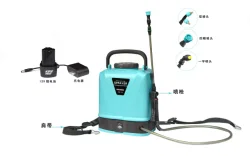Maintaining Your Garden Sprayer: Tips for Longevity and Optimal Performance
2024-08-24
A garden sprayer is a valuable tool for maintaining your garden, but its performance and longevity depend on proper maintenance. Regular care and attention can ensure your sprayer functions efficiently and lasts for years. Here are some essential tips for maintaining your garden sprayer and keeping it in top condition.
1. Regular Cleaning
Proper cleaning is crucial for maintaining the performance of your garden sprayer and preventing clogs or residue buildup. Follow these cleaning tips:
After Each Use: Rinse the sprayer thoroughly with water to remove any leftover chemicals or solutions. Pay special attention to the nozzle and interior components.
Deep Cleaning: Periodically, disassemble the sprayer and clean each part separately. Use a mild detergent or cleaning solution to remove stubborn residue. Make sure to rinse all components thoroughly to avoid chemical reactions with future solutions.
2. Proper Storage
Storing your garden sprayer correctly helps prevent damage and prolongs its lifespan. Consider these storage tips:
Empty the Sprayer: Before storing, empty any remaining solution from the sprayer. This prevents residue buildup and potential corrosion.
Dry Completely: Allow the sprayer to dry thoroughly before storing it. This helps prevent mold and mildew growth inside the sprayer.
Store in a Cool, Dry Place: Keep the sprayer in a cool, dry location away from direct sunlight and extreme temperatures. Avoid storing it in areas where it may be exposed to freezing temperatures, as this can damage the components.
3. Inspect and Maintain Components
Regularly inspect and maintain the components of your garden sprayer to ensure optimal performance:
Check for Leaks: Inspect the sprayer for any leaks or cracks in the tank, hoses, or nozzles. Address any issues promptly to prevent further damage.
Replace Worn Parts: Over time, certain parts of the sprayer, such as seals, gaskets, or hoses, may wear out. Replace these parts as needed to maintain the sprayer’s functionality.
Lubricate Moving Parts: Apply lubrication to moving parts, such as the pump mechanism or trigger, to ensure smooth operation and prevent rust or corrosion.
4. Handle Chemicals Safely
Proper handling of chemicals and solutions is essential for both safety and maintenance:
Follow Instructions: Always follow the manufacturer’s instructions for mixing and applying chemicals. This helps prevent chemical reactions that could damage the sprayer or harm your plants.
Wear Protective Gear: When handling chemicals, wear appropriate protective gear, such as gloves and safety goggles, to protect yourself from exposure.
5. Troubleshooting Common Issues
Here are some common issues with garden sprayers and how to troubleshoot them:
Clogged Nozzle: If the nozzle becomes clogged, clean it thoroughly or use a needle to clear any blockages. Ensure the nozzle is properly adjusted for the desired spray pattern.
Low Pressure: If you experience low pressure, check the pump for any issues or air leaks. Ensure the tank is properly pressurized and that all seals are intact.
Uneven Spray: If the sprayer produces an uneven spray, check for clogs or obstructions in the nozzle or hose. Adjust the nozzle settings as needed for even coverage.
6. Seasonal Maintenance
Perform seasonal maintenance to prepare your garden sprayer for different times of the year:
Before Storage: Clean and dry the sprayer thoroughly before storing it for the off-season. Check for any wear or damage and address it before storage.
Spring Preparation: Before using the sprayer for the new season, inspect it for any issues and ensure it is in good working condition. Test it with water before applying any solutions.
In conclusion, maintaining your garden sprayer is essential for ensuring its longevity and optimal performance. By following these tips for cleaning, storage, component inspection, and handling chemicals, you can keep your sprayer in excellent condition and enhance your gardening experience. Proper care will ensure your garden sprayer remains a reliable tool for all your gardening needs.



